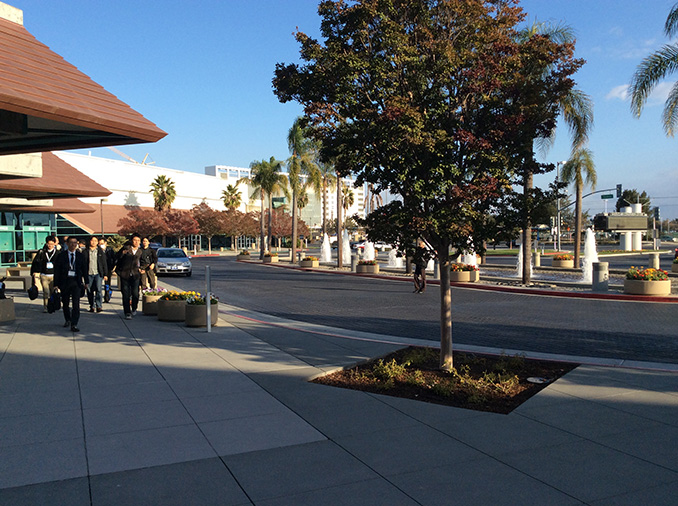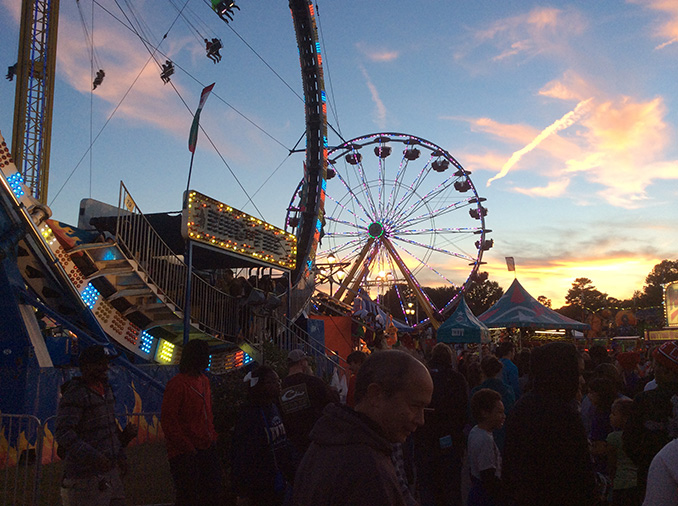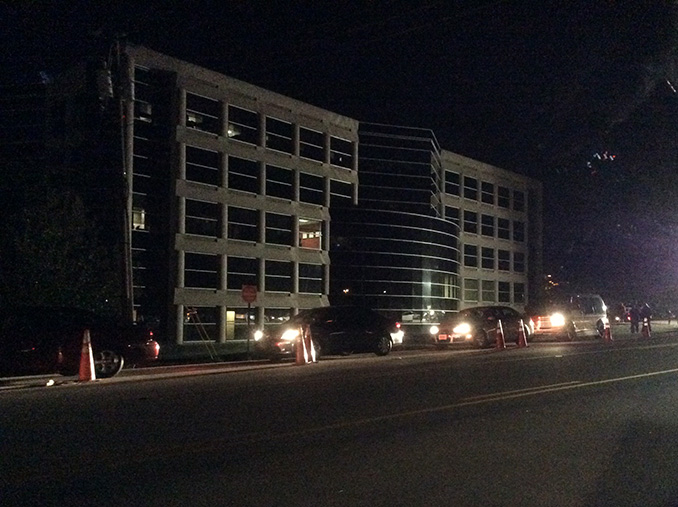The iPad Air Review
by Anand Lal Shimpi on October 29, 2013 9:00 PM ESTCamera
Front and rear facing cameras are necessary features on all modern, premium tablets. The usage model for a rear facing camera on a tablet is hopefully not as a primary image capture device but rather a convenient one. The idea being that if you’re on location somewhere using the iPad for work or play and need to quickly grab an image, having a decent rear facing camera can come in handy rather than having to put away your tablet, pull out your phone and then switch back afterwards.
Apple has improved its iPad imaging systems almost every single generation. That being said, the iPad Air is a bit of an exception to the rule as it retains the same rear camera sensor as the 4th generation iPad. We’re still talking about a 5MP sensor with f/2.4 lens, although the iPad Air now has a wider field of view with a 3.3mm focal length (identical to the original iPad mini).
| Rear Facing Camera Comparison | |||||||
| Sensor | Resolution | Aperture | Focal Length | ||||
| Apple iPad Air | 5MP | 2592 x 1936 | f/2.4 | 3.3mm | |||
| Apple iPad 4 | 5MP | 2592 x 1936 | f/2.4 | 4.3mm | |||
| Apple iPad 3 | 5MP | 2592 x 1936 | f/2.4 | 4.3mm | |||
| Apple iPad 2,4 | 0.7MP | 960 x 720 | f/2.4 | 2.0mm | |||
| Apple iPad mini | 5MP | 2592 x 1936 | f/2.4 | 3.3mm | |||
The rear facing camera tends to shoot at lower ISOs than the rear camera on the iPad 4. Since there’s no substantial change in the sensor or lens system however, the result is less noise but a darker image in low light situations. I suspect this might be more of a configuration default for the software layer driving the H6 ISP in Apple’s A7. Image quality is surprisingly good:
Even lower light shots come out fairly well:
Although obviously noise goes up appreciably once you get into really dark scenes:
I took a bunch of photos at the NC State Fair as well as on my trip out to Santa Clara following the iPad launch event in the gallery below.
Despite using the same ISP as the iPhone 5s, there’s no 10 fps burst capture mode on the iPad Air. Similarly there’s no slo-mo video recording mode either. The iPad Air does inherit the other benefits of the new H6 ISP however. Image capture is still insanely quick, which makes me wonder if the A7’s ISP also leverages that large on-die system cache.
| Front Facing Camera Comparison | |||||||
| Sensor | Resolution | Aperture | Focal Length | ||||
| Apple iPad Air | 1.2MP | 1280 x 960 | f/2.4 | 2.15mm | |||
| Apple iPad 4 | 1.2MP | 1280 x 960 | f/2.4 | 2.18mm | |||
| Apple iPad 3 | 0.3MP | 640 x 480 | f/2.4 | 1.8mm | |||
| Apple iPad 2,4 | 0.3MP | 640 x 480 | f/2.4 | 1.8mm | |||
| Apple iPad mini | 1.2MP | 1280 x 960 | f/2.4 | 2.2mm | |||
The front facing camera does see an improvement in sensitivity thanks to a larger sensor format. My understanding is this is the same sensor/lens combination as what’s in the iPhone 5s and 5c. Similarly to its implementation in the 5s, Apple seems to use the new front facing camera system to drive to lower ISOs and/or higher shutter speeds. You typically end up with a lower noise/sharper image, although sometimes there is a brightness/exposure tradeoff.
The other feature leveraged by the new front facing camera is the inclusion of a second microphone for noise cancellation. The goal here is to use the second mic to cancel out background noise and improve the quality of the audio you’re actually trying to record (presumably your voice during FaceTime for example). The impact is pretty noticeable. I ran an iPad 4 and an iPad Air side by side while playing a background track and have embedded the resulting videos below:
In the iPad Air sample video my voice comes across considerably clearer, as you’d expect given the Air’s second mic.
Video
Video capture settings look unchanged from the iPad 4. We’re still dealing with ~17Mbps High Profile videos from the rear camera and ~10Mbps Baseline Profile H.264 from the front camera.
Video quality out of both is pretty good for a tablet. In well lit scenes rear camera quality is definitely sufficient for sharing on the web.




















444 Comments
View All Comments
stingerman - Sunday, November 3, 2013 - link
Yes, I haven't even seen one of those in use other than commercials. Real failures...stingerman - Sunday, November 3, 2013 - link
lol, you're hilarious! iOS is Unix plus all the major OS X frameworks plus all the new iOS frameworks... It maybe light because of its elegance, but it's a light nuclear weapon...lilo777 - Sunday, November 3, 2013 - link
LOL. Do you know any version of Unix that does not have a file system (exposed to user)?Krysto - Friday, November 1, 2013 - link
Offtopic, but Anand, the announcement of Mali T760 is suspiciously missing from this site.Over 300 GFLOPS, which is more than PS3 and should make it pretty competitive with mobile Kepler, along with ASTC compression by default, much more efficient, and has some interesting features like hardware assisted global illumination.
ARM's announcement:
http://community.arm.com/groups/arm-mali-graphics/...
michael2k - Friday, November 1, 2013 - link
Yeah, the T700 series is for next generation devices, or in other words, products in the next 12 months. The PowerVR6 series is available now for this generation and up to 1000 GFLOPS.Krysto - Saturday, November 2, 2013 - link
Do you see that 1000 GBFLOPS in any smartphone? Just because it can be scaled that much, doesn't mean they WILL for smartphones. This GPU will be used in smartphones a year from now. What does the GPU in Apple's A7 have now? ~100 GFLOPS?Anyway, the Mali T760 seems very competitive with what will be out there a year from now, and Anandtech usually writes about these sort of announcements.
michael2k - Monday, November 4, 2013 - link
I think you've missed the point.1) We aren't in a smartphone thread
2) The PowerVR6 will scale to 1000 GFLOPs; so when the T700 comes out next year, the PowerVR will be ready
3) The Air is at about 115 GFLOPs, about 2x the outgoing iPad 4, and will therefore be approximately 230 GFLOPs in the A8 next year, if 2x, or 340 GFLOPs if 3x
So you are correct that the Mali T760 will be competitive next year, but this article is about this year.
michael2k - Monday, November 4, 2013 - link
You've missed the point.The PVR6 is 115GF today in the Air, and when needed to compete with the T700 can hit 300GF.
Likewise, we are in a thread about tablets, where it is much more likely to scale to the needed 300GF.
Krysto - Saturday, November 2, 2013 - link
What you said also reminded me of how Intel promoted "Haswell graphics"."Hey, look, out "Haswell GPU" (Iris Pro 5200) is 3x faster than IVB!" - and then you only see crappy 4600 in most devices, including the Surface Pro, which is only 20 percent faster than last year's IVB GPU.
Or "look at our awesome new 2.6 Ghz Silvermont CPU's! - and then you only see 1.3 ghz Silvemont for tablets, because the 2.6 Ghz ones are not viable either because of too high TDP or price, which makes them pretty irrelevant. What's relevant is what will be in the market, not their pie-in-the-sky CPU's that never get on the shelves.
ashleyuv - Saturday, November 2, 2013 - link
This is a very interesting review, even for someone without the tech or IT background to follow all of it. In particular, I like the way, in the last part, you show how the increase to 64-bit and the DRAM size (remaining the same), while seeming like a no-brainer and conservative decisions, respectively, are actually a smart play, albeit one with consequences.In agreement with one of your readers, I'd have to say that "review" is really the wrong word for this. It is all but a scientific study. But again, it's written for people who may not have an extensive tech background.
Thank you! I will be reading more in the future (just discovered your site).